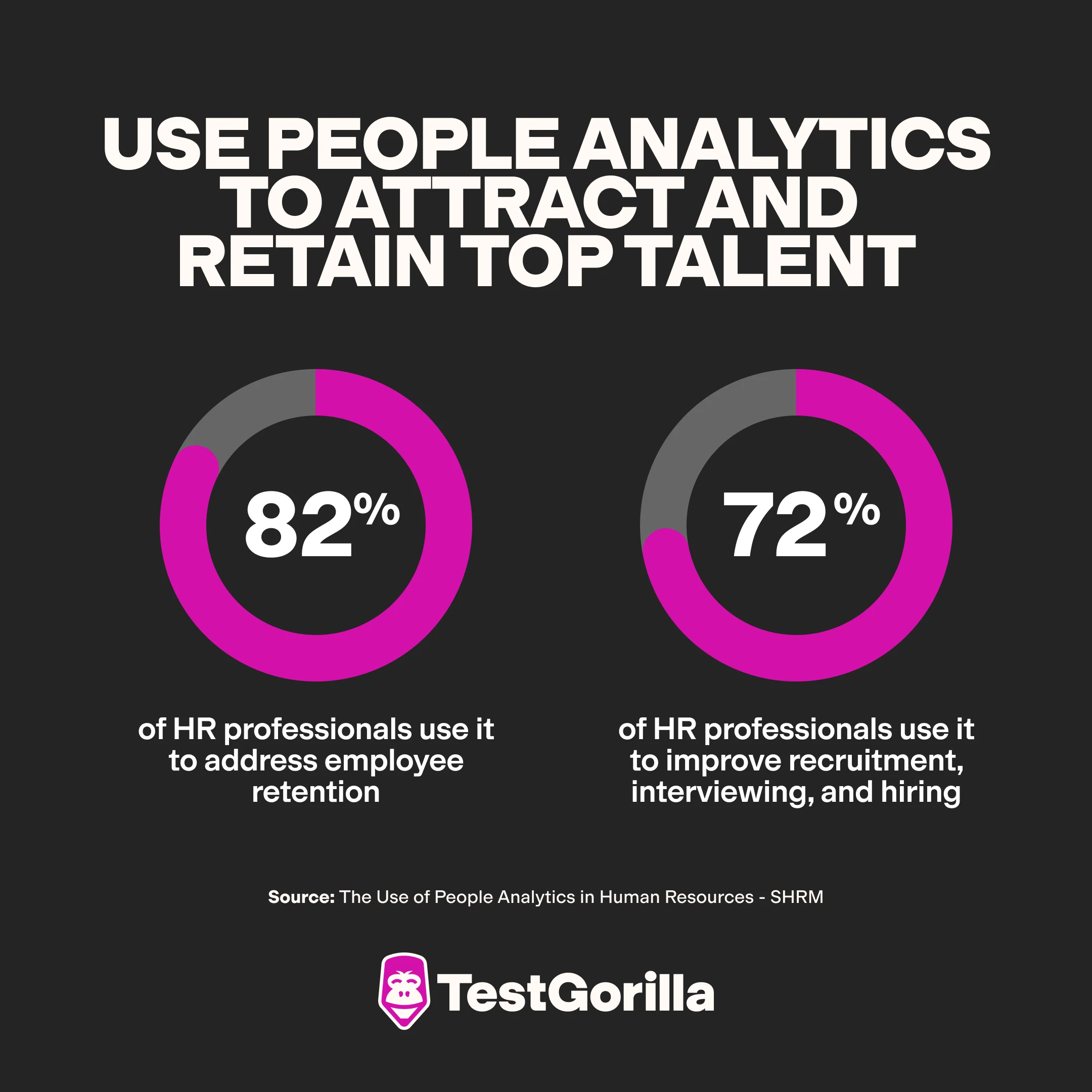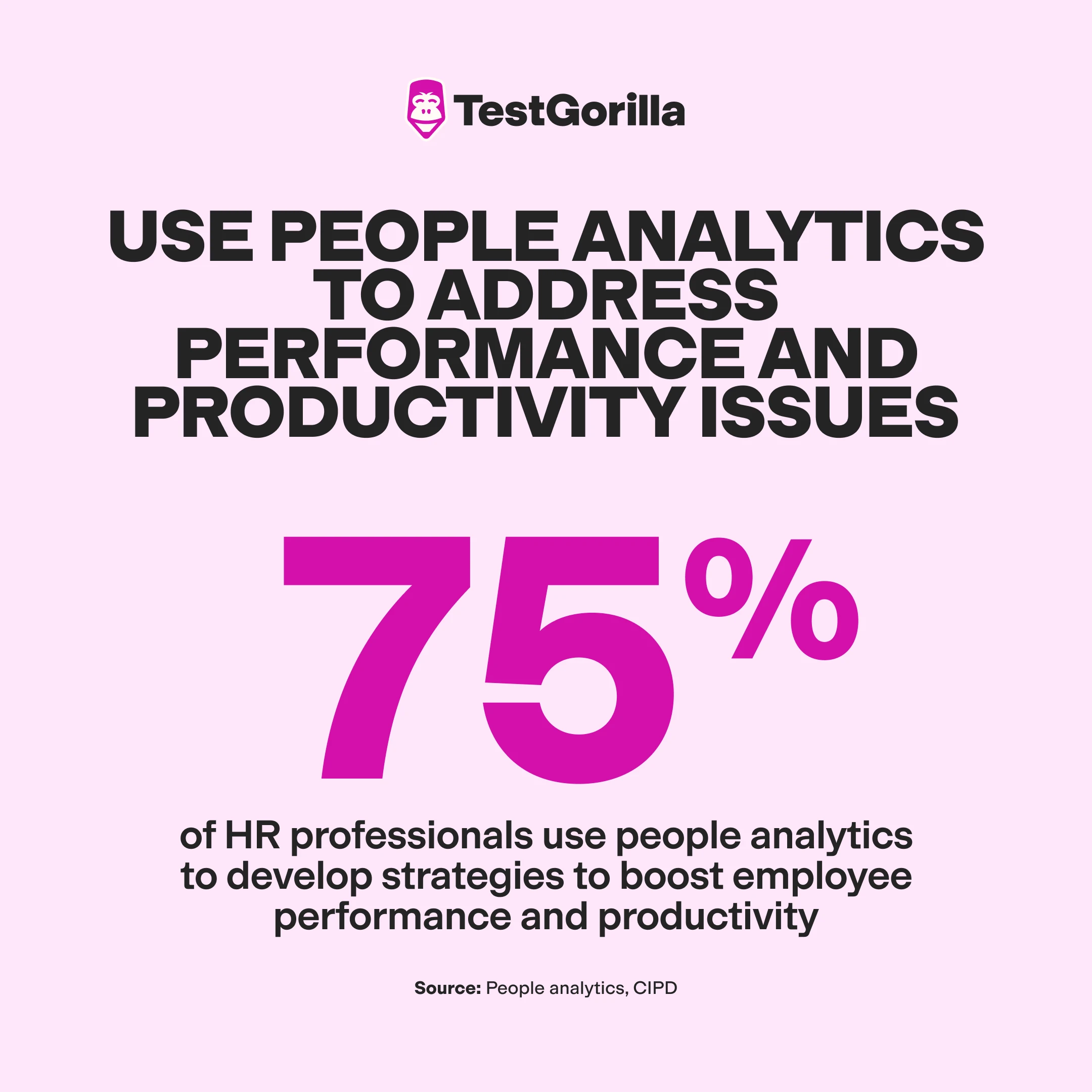How to use strategic HR data analysis to unlock long-term success
According to human capital consulting firm Aon, “harnessing data and analytics to make better workforce decisions” is one of the top five HR trends in 2024. [1]
While many organizations have quickly jumped on this trend, only 22% of HR professionals feel their company uses HR or people analytics effectively. [2]
If you’re one of the 78% of HR professionals who believe their organization is underutilizing these tools, read on. We explore how HR analytics is a powerful tool for delivering detailed insights into your HR strategies. Plus, we show through several ways to use it strategically and the best practices for protecting employee data.
Table of contents
- HR metrics: the building blocks of strategic HR data analysis
- Moving beyond HR metrics: Strategic HR analytics
- 6 ways to use HR data analytics strategically
- Practical tips for using strategic HR data analysis
- Data privacy and ethics: Best practices
- Using strategic HR analytics to improve business outcomes
HR metrics: the building blocks of strategic HR data analysis
HR metrics – the foundation of HR analytics – are data about your workforce and HR activities, including recruitment, performance, and engagement. By tracking HR metrics, you can measure the effectiveness and efficiency of your broader HR activities or specific HR strategies.
Here are some examples of crucial HR metrics organizations track:
Time-to-hire is a recruitment metric that measures the average number of days between candidates submitting their applications and accepting job offers.
Voluntary turnover measures the rate at which employees voluntarily leave an organization. It’s important to track due to the cost of replacing an employee, which the Society of Human Resource Management (SHRM) estimates to be at least $4,700.
Employee engagement is often measured through a combination of metrics like absenteeism, performance reviews, and Employer Net Promoter Score (eNPS).
Productivity metrics vary between organizations and their definitions of productivity. Common metrics include billable hours per employee, revenue per employee, or project completion times.
Diversity metrics indicate the level of representation of certain groups within an organization – for example, the percentage of women, Black employees, or people with disabilities – indicating the effectiveness of DEI initiatives.
You can draw HR metrics from various sources, including internal company data from applicant tracking systems (ATS) and talent assessment software, employee pulse surveys or performance interviews, and data collection tools like time tracking software.
Moving beyond HR metrics: Strategic HR analytics
HR metrics provide a snapshot of your organization's current state of HR. However, they don’t necessarily help you understand why a problem is happening, what you can do to address it, or how you could avoid the issue in the first place.
HR analytics moves beyond the numbers, offering practical insights into the data organizations can use to develop strategies or guide decision-making. It involves collecting, analyzing, and reporting on one or more HR metric to:
Understand exactly what your HR metrics represent at certain points in time.
Highlight HR issues, their causes, and solutions.
Pinpoint effective HR strategies and processes and understand why they work.
Identify future HR trends, risks, and opportunities.
It involves talent analytics (which analyzes recruitment and retention strategies) and people analytics (which examines larger workforce behaviors and trends).
For example, raw HR data may reveal low employee engagement levels. By analyzing this along with other company data – including compensation, job satisfaction, and well-being – an organization may identify that female employees' engagement levels are especially low due to a perceived pay gap between them and their male colleagues.
This makes strategic HR analysis a powerful tool for not just HR teams but also organizations more broadly. According to PricewaterhouseCoopers (Pwc), “When used strategically, analytics can transform how HR operates by equipping managers with insights and allowing HR to actively and meaningfully contribute to the organisation’s bottom line.”
Many organizations recognize this. Professional services firm Insight 222 surveyed 271 companies worldwide for its People Analytics Trends 2023 study. It found that people analytics functions have grown by 43% on average between 2020 and 2023, with 90% of companies increasing or maintaining the size of their people analytics teams.
But not all organizations are using HR analytics to its full potential. This can be a result of:
Relying on metrics alone
Failing to clearly define the objectives of analytics
Relying on poor-quality data
Relying solely on numerical data (like turnover rate) and not using qualitative insights (like feedback from exit interviews)
Focusing on the wrong metrics (for instance, attendance rates alone aren’t a good representation of engagement since present employees aren’t necessarily engaged)
Creating data silos that prevent information-sharing
Not hiring people with the right analytics expertise or not providing the right training to your analytics team
When using HR analytics, carefully consider how to apply it strategically to support organizational goals.
6 ways to use HR data analytics strategically
Here are several ways that strategic HR data analysis can be a transformative tool for your business.
1. Attract and retain top talent
Developing strategies to attract (and keep) the best candidates is one of HR analytics' most popular use cases.
SHRM spoke to 2,149 HR professionals and 182 HR executives working for companies that use people analytics. According to this research, 82% of HR professionals who work for organizations that use people analytics are using it to address employee retention and turnover, while 72% are using it to improve recruitment, interviewing, and hiring.
For example, your organization can use analytics to:
Identify the most effective hiring channels
Optimize job descriptions
Highlight the stages of the hiring process with the most candidate drop-offs and the cause
Monitor employee engagement and job satisfaction to identify and address potential problems causing employees to leave
Offer personalized employee training and development programs
Improve workplace culture
Speaking to McKinsey, David Green, HR expert and co-author of Excellence in People Analytics, gave this example of the impact of HR analytics on recruitment:
One big investment bank that I spoke to recently is using analytics to help hiring managers understand that if they use education and experience in their role profiles, how many applicants they’re likely to get and, if they tweak one or two things, how that might make a change to the applicants.
2. Increase employee engagement
HR analytics helps you understand the why behind employee engagement levels and develop tailored strategies to improve it. Given the impact of employee engagement on productivity and companies’ financial performance, leveraging these insights can lead to better results in both areas.
Key metrics like employee satisfaction, retention, and performance offer detailed insights into engagement and potential motivating factors that can increase engagement, such as compensation, team size, or management style.
For example, as a result of HR analytics, electronics retailer Best Buy valued a 0.1% increase in employee engagement in a store at over $100,000 in the store’s annual income. Based on this information, Best Buy started conducting employee surveys quarterly rather than annually to track employee satisfaction more closely and address issues as they arose.
3. Address performance and productivity issues
A joint Workday and CIPD survey of 3,853 professionals across various departments and countries found that 75% of HR professionals use people analytics to develop strategies to boost employee performance and productivity. It’s easy to see why.
Detailed insights into how employees work, the processes they follow, and the results they produce help you identify bottlenecks or other productivity issues. With this information, you can understand the underlying causes and develop targeted strategies to address them, such as:
Tailoring your training and development opportunities to specific teams or individual employees.
Identifying employees who need more support from their managers or supervisors.
Highlighting the most effective processes and approaches to replicate across your organization.
Improving productivity has a direct impact on your organization’s bottom line. In the Workday and CIPD survey, 65% of survey respondents who work in an organization with a strong people analytics culture said their business performance was strong compared to competitors.
A great example? Microsoft used people analytics to answer the eternal post-pandemic question: Should employers require employees to return to the office?
The company’s data identified specific situations where in-person attendance is highly effective, such as onboarding and new product launches. However, it also showed that employees generally don’t achieve the full benefits of in-person attendance when working alone. As a result, Microsoft employees are free to choose the days they attend the office.
4. Guide and evaluate HR investment
HR analytics also helps improve your organization’s bottom line by ensuring the best ROI on HR investments. For example, you can use HR analytics to identify top performers and future leaders and nurture this talent. Or, you can highlight and prioritize training and development opportunities for your workforce.
Plus, you can quantify the impact of your HR initiatives. This helps you understand what does and doesn’t work or which strategies are the most effective.
For instance, a pharmaceutical company wanted to review the effectiveness of its well-being programs in light of increasing healthcare costs. Aon, the consulting firm the company engaged, reviewed its well-being and productivity data and found that improved individual well-being increased productivity by 5% on average – or $3,500/employee. Since this far outweighed the cost of the company’s well-being program (around $500/employee), it was an initiative worth keeping.
5. Improve DEI in your workplace
Research by David Green and Jonathan Ferrar, authors of Excellence in People Analytics, found that 54% of organizations said DEI is one of the top three areas where people analytics adds the most value.
HR analytics is an incredibly effective tool in this space. According to SHRM, 70% of HR professionals who use people analytics say it helps them achieve their DEI goals.
You can use HR analytics to:
Highlight underrepresented groups in your workforce. This may prompt you to review your hiring and promotion strategies to promote diversity in your workforce.
Identify employees who feel excluded. For example, a high turnover rate of a particular demographic may speak to underlying inclusion issues.
Reveal equity issues. For instance, analyzing wage data, roles, and responsibilities may identify gender or other pay gaps to address.
Dawn Klinghoffer, Head of People Analytics at Microsoft, explains the tech giant’s approach to using HR analytics to improve DEI. “We use data first to measure, then to learn, then to take different actions, then to measure again and to learn again.”
6. Future-proof your business
Forecasting is one of the most powerful features of HR analytics. Many HR analytics platforms can review historical data (both internal and external) to identify future HR trends, issues, and opportunities.
These valuable insights help your organization maintain a competitive advantage, effectively plan long-term, and make better decisions.
We can see how valuable this aspect of HR analytics is in supporting a skills-based approach to hiring. Taking a data-driven approach, you can perform a skills gap analysis to assess the current skills in your organization, spot the skills you’ll need in the future, and identify any gaps between what you have and what you need. Then, you can tailor your hiring strategies to proactively recruit for the skills you’ll need, avoiding future skills shortages.
Practical tips for using strategic HR data analysis
Here’s how to harness the full potential of HR analytics:
Prioritize data-driven decision-making in your organization by ensuring everyone – not just the HR department – understands the strategic value of HR analytics. Case studies that demonstrate the power of analytics might get everyone on board with this priority.
Identify clear objectives for your analytics to guide data collection and analysis. For instance, in an effort to improve your employee development programs, you might start measuring employees’ performance metrics before and after they complete these programs to track how the programs improve over time.
Align your HR analytics objectives with broader organizational goals and strategies. For example, the objective to improve employee development might align with the broader goal to retain more employees.
Review your data to identify any gaps and ways to collect this missing data. For instance, if you’re missing data on development programs your employees are most interested in, employee surveys or one-on-ones might be a good way to collect this information.
Use reliable HR data analytics software to track HR metrics and analyze them. Check out our review of the five best HR analytics tools. Ideally, your chosen software should integrate with and compile data from your existing tech stack – such as your skills testing platform, ATS, and employee engagement tools.
Ensure the right people have access to HR data to avoid data silos. For instance, don’t keep all data on your tech employees in your tech department.
Deliver regular data literacy training to employees who use analytics. You should also test the skills of your analyst candidates before hiring them. This way, you can see if they have the data literacy skills you need – or address their skills gaps with tailored onboarding and training.
Data privacy and ethics: Best practices
HR analytics involves collecting employee data – including personal data. With increasing cybersecurity threats and attacks on organizations, prioritizing data security is essential.
This also helps reduce your risk of compliance issues and the costly penalties that can follow, while building employee trust. According to SHRM’s research, 40% of employees would likely or definitely quit if they found out their employer was misusing information about them.
Here’s how to protect the data you collect.
1. Follow data security rules, regulations, and guidelines
Ensure any data collected for HR analytics complies with relevant data protection laws and regulations.
Depending on your business and employees' location(s), several data protection laws may apply to your organization. These include the:
EU General Data Protection Regulation (GDPR)
UK Data Protection Act (UK GDPR)
California Consumer Privacy Act (CCPA)
The Federal Trade Commission and the US Chamber of Commerce also provide helpful guidelines for businesses on protecting employees’ personal data.
2. Develop strong data privacy policies and procedures
A robust data privacy policy gives employees a central reference point for secure data management. It should address issues like:
How and when employee data is collected
The purposes for its collection
Who has access to the data (only staff with a genuine need should get access)
Beyond this, practices you can use to help protect employee data include:
Clearly communicate your employee data protection policy and procedures to employees – for example, by linking to them in your employee handbook or intranet.
Ensure your data collection and analysis software tracks which users have accessed information and when.
Encrypt employee personal data and use multi-factor authentication access.
Use reliable anti-virus and anti-malware software.
Train your employees about data security to help them understand their rights and responsibilities.
Conduct regular security audits to identify and address any risks or breaches immediately.
3. Be transparent with employees
Inform your employees that you collect their data – and explain how you use their data and the benefits of HR analytics. This way, they’re more likely to feel comfortable with and support HR analytics.
Plus, according to a study conducted by Slack involving over 1,400 US workers, 87% of employees want transparency from future employers. Data transparency promotes accountability and protects the relationship of trust between your organization and employees.
To ensure data transparency, use the practices outlined above, make the results of your findings available, and encourage employees to provide feedback on your data collection processes.
4. Appoint a person or team to oversee the use of people data
According to Insight222, ethics is one of the eight characteristics leading companies in people analytics display. A common ethical practice? Having a forum or council to review the use of people data and analytics.
Depending on the size of your business, consider appointing a person or team to monitor HR analytics in your organization, including any ethical considerations or impacts it has.
5. Take a considerate approach to AI
Most HR data analytics software includes AI features, especially for predictive analytics. While AI offers enormous potential for analyzing large amounts of complex data, you must use it ethically so it doesn’t negatively impact your employees’ rights.
Take steps like developing a clear AI policy, training your HR team on the ethical use of AI, and vetting the analytics tools you use to ensure they comply with legal and ethical obligations.
Using strategic HR analytics to improve business outcomes
Insights from HR analytics can help improve HR decision-making, hiring strategies, employee engagement, workplace DEI, and overall business outcomes.
To use it strategically, craft clear objectives, align these with broader goals, use reliable analytics software, and more. Protect your employees’ data through a combination of robust data security policies and procedures, employee training, and legal compliance.
Data is power. By using HR analytics strategically and responsibly, you can ensure your organization's future success.
Disclaimer: The information in this article is a general summary for informational purposes and is not intended to be legal advice. Laws are subject to constant change, and their application varies based on your individual circumstances. You should always seek legal advice from a qualified attorney about your legal obligations as an employer. While this summary is intended to be informative, we cannot guarantee its accuracy or applicability to your situation.
Sources
[1] “Five Big Human Resources Trends to Watch in 2024.” (2024). Aon. https://www.aon.com/en/insights/articles/five-big-hr-trends-to-watch-in-2024.
[2] “State of People Analytics 2023-2024 Report.” (2023). HR.com. https://www.crunchr.com/app/uploads/2023/10/HRdotcom-Crunchr-State-of-HR-Report.pdf.
Related posts
You've scrolled this far
Why not try TestGorilla for free, and see what happens when you put skills first.
Latest posts
The best insights on HR and recruitment, delivered to your inbox.
Biweekly updates. No spam. Unsubscribe any time.

Skills tests to hire the best
Our screening tests identify the best candidates and make your hiring decisions faster, easier, and bias-free.
Free resources
A step-by-step blueprint that will help you maximize the benefits of skills-based hiring from faster time-to-hire to improved employee retention.
With our onboarding email templates, you'll reduce first-day jitters, boost confidence, and create a seamless experience for your new hires.
This handbook provides actionable insights, use cases, data, and tools to help you implement skills-based hiring for optimal success
A comprehensive guide packed with detailed strategies, timelines, and best practices — to help you build a seamless onboarding plan.
This in-depth guide includes tools, metrics, and a step-by-step plan for tracking and boosting your recruitment ROI.
Get all the essentials of HR in one place! This cheat sheet covers KPIs, roles, talent acquisition, compliance, performance management, and more to boost your HR expertise.
Onboarding employees can be a challenge. This checklist provides detailed best practices broken down by days, weeks, and months after joining.
Track all the critical calculations that contribute to your recruitment process and find out how to optimize them with this cheat sheet.
















